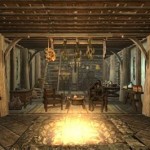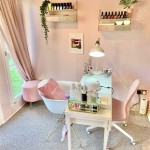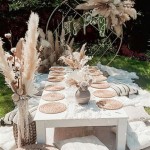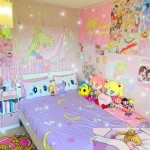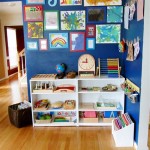Small Side Table Decor Ideas: Maximizing Style in Limited Spaces
Small side tables are versatile pieces of furniture that offer both functionality and aesthetic appeal, particularly beneficial in compact living spaces. They serve as convenient surfaces for lamps, books, beverages, and decorative items, while simultaneously contributing to the overall ambiance of a room. Choosing the right decor for a small side table requires careful consideration of size, style, and purpose, ensuring that the table enhances rather than overwhelms the space it occupies. This article explores a range of small side table decor ideas, providing practical guidance for creating visually appealing and functionally optimized arrangements.
Prioritizing Functionality and Accessibility
Before focusing on purely aesthetic elements, it is crucial to consider the primary function of the side table. Is it intended to hold a reading lamp beside a bed, a remote control in a living room, or a plant in a sunroom? Identifying the table's primary purpose will dictate the type and quantity of items that should be placed on it. For example, a bedside table needs ample space for a lamp, a book, and perhaps a glass of water, while a living room side table might prioritize coasters, a decorative tray, and a small plant.
Accessibility is another key consideration. Items that are used frequently should be easily within reach. A bedside table should allow easy access to a lamp switch or a phone charger, while a living room side table should provide convenient access to remote controls and drink coasters. Clutter should be minimized to maintain a clear and accessible surface. Overcrowding a small side table with too many items can make it difficult to find what is needed and detract from the overall aesthetic appeal.
Consider the table's dimensions and the height of surrounding furniture. A side table that is too low or too high in relation to the adjacent sofa or bed will be less functional and visually jarring. Ideally, the top of the side table should be roughly level with the arm of a sofa or the top of a mattress. The footprint of the side table should also be proportional to the size of the room and the surrounding furniture. A small table in a large room might appear insignificant, while a large table in a small room might feel overwhelming.
Balancing Form and Texture: Creating Visual Interest
Once functionality is addressed, the focus can shift to creating visual interest through the strategic use of form and texture. A well-decorated side table should incorporate a variety of shapes, sizes, and materials to create a layered and dynamic look. The use of contrasting textures can also add depth and dimension to the arrangement.
One effective technique is to create a triangular arrangement of objects, varying in height and width. This can be achieved by placing a taller object, such as a lamp or a vase, at the back of the table and flanking it with smaller items, such as a stack of books or a decorative box. The triangular arrangement draws the eye upward and creates a sense of balance.
The choice of materials can also contribute to the overall visual appeal. Combining different textures, such as smooth glass, rough wood, and soft fabric, can add depth and interest to the arrangement. For example, a glass lamp with a linen lampshade placed on a wooden table can create a pleasing contrast of textures. Metallic accents, such as a silver tray or a gold picture frame, can also add a touch of glamour and sophistication.
Consider the color palette of the room and choose decor items that complement or contrast with the existing color scheme. Neutral colors, such as white, gray, and beige, provide a versatile backdrop for adding pops of color through accessories. Bold colors, such as red, blue, and yellow, can be used to create a focal point and add energy to the space. However, it is important to avoid overwhelming the table with too many colors, as this can create a cluttered and chaotic look.
Small artwork, such as framed prints or photographs, can also add personality and visual interest to a side table. Choose artwork that complements the style of the room and reflects personal tastes. Leaning the artwork against the wall, rather than hanging it, can create a more relaxed and informal look. Consider the size of the artwork in relation to the size of the table; a piece that is too large can overwhelm the space, while a piece that is too small might be lost in the overall arrangement.
Incorporating Personal Touches and Meaningful Objects
Beyond functionality and aesthetics, a well-decorated side table should also reflect personal style and incorporate meaningful objects. These objects can serve as conversation starters and add a sense of warmth and personality to the space. The inclusion of personal touches can elevate a simple side table arrangement from merely functional to genuinely expressive.
Consider incorporating items that hold sentimental value, such as family photos, travel souvenirs, or handmade crafts. These items can add a personal touch and create a connection to the past. A small collection of vintage postcards, a handcrafted vase, or a framed photograph of a loved one can all contribute to the overall ambiance of the room.
Books are another excellent way to add personality and visual interest to a side table. Choose books that reflect personal interests and passions. A stack of art books, a collection of classic novels, or a coffee table book on travel can all contribute to the overall aesthetic. Arrange the books in a visually appealing way, such as stacking them horizontally or vertically, and consider using decorative bookends to add a touch of style.
Plants and flowers can also bring life and vibrancy to a side table arrangement. A small potted plant, a vase of fresh flowers, or even a single succulent can add a touch of nature and create a sense of tranquility. Choose plants that are appropriate for the lighting conditions in the room and that require minimal maintenance. Succulents, air plants, and snake plants are all good options for low-maintenance greenery.
Decorative boxes and trays can be used to corral smaller items and keep the table looking organized. These items can also add a touch of style and sophistication. Choose boxes and trays that complement the color scheme and style of the room. A lacquered box, a woven tray, or a marble coaster can all add a touch of elegance to the arrangement.
The careful selection and placement of decor items can transform a simple side table into a focal point of a room. By prioritizing functionality, balancing form and texture, and incorporating personal touches, it is possible to create a visually appealing and functionally optimized arrangement that reflects individual style and enhances the overall ambiance of the space.

Home Decor 101 How To Decorate End Tables Living Room Table Accent

9 Gorgeous Accent Table Décor Ideas Living Spaces

Simplified Decorating End Table Decor Ideas Bless Er House

Driven By Decor Living Room Corner

Beautiful Coffee Table Arrangement And Styling Ideas For Your Living Room

27 Coffee Table Decor Ideas How To Style A Modern

Simplified Decorating End Table Decor Ideas Bless Er House

Accent Table Decor Living Room Side Decorating Ideas Perfect Combination Of Decorative Small

27 Coffee Table Decor Ideas How To Style A Modern

How To Decorate A Nightstand The Sommer Home
Related Posts
